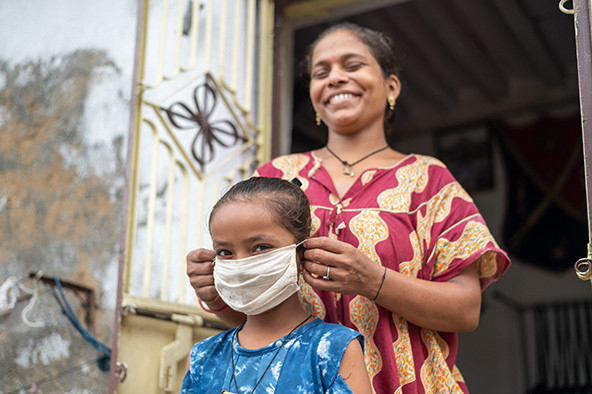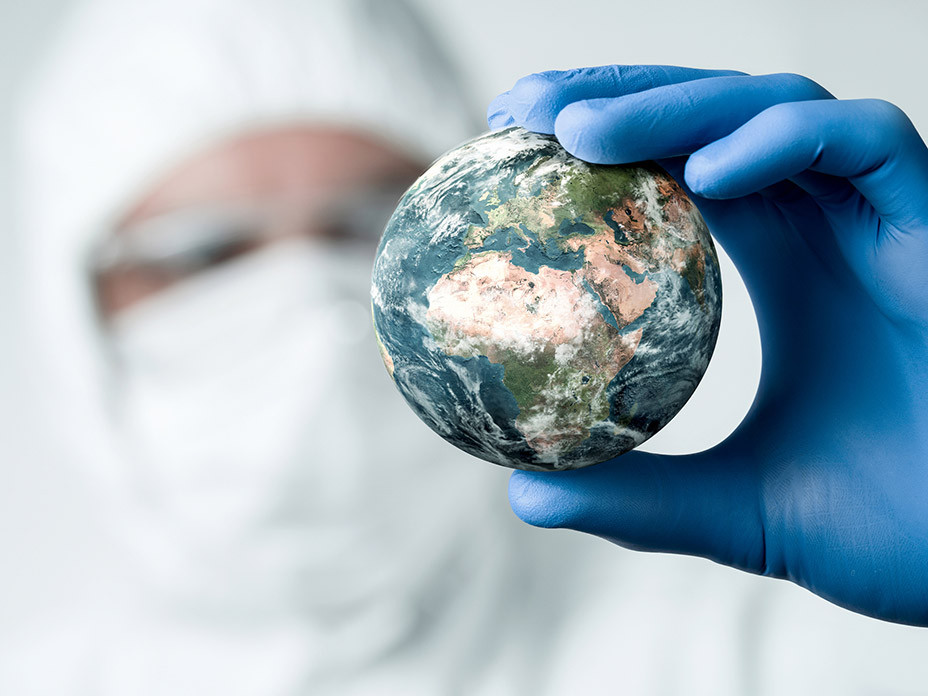 UNICEF used resources from the COVID-19 Solidarity Response Fund to support efforts to inform people in India about taking steps to protect themselves during the COVID-19 pandemic. (Photo courtesy of UNICEF)
UNICEF used resources from the COVID-19 Solidarity Response Fund to support efforts to inform people in India about taking steps to protect themselves during the COVID-19 pandemic. (Photo courtesy of UNICEF)
In the early stages of the COVID-19 pandemic last year, health care workers around the world were in desperate need of personal protective equipment (PPE), virus testing kits, and other essential supplies. At the same time, the health-focused global supply chains and factories that might meet the demand were hobbled not just by disruptions from the virus but also an inability to increase capacity quickly.
The organization leading the global health response to COVID-19, the World Health Organization (WHO), knew that overcoming these challenges would require solutions that were extraordinarily quick, extensive, adaptable, and costly. Getting fast access to substantial funds that could be flexibly spent would make the difference between life and death, as veterans of many disasters know.

Several barriers stood in the way. Like many international organizations, the WHO depends on support from governments, which can be slower to distribute funds and also restrict how monies can be used. Additionally, during the early stages of COVID-19, governments understandably prioritized their own nations' health crises, leaving even fewer resources to share. Finally, even if the WHO wanted to tap into alternative sources of funding, it lacked the infrastructure to receive donations at scale from entities other than United Nations member states.
What it needed was a way to rapidly involve what the WHO would normally consider non-traditional donors—the millions of individuals, philanthropies, and companies around the world who were ready and willing to support its response to the pandemic.
Enter the COVID-19 Solidarity Response Fund. The project—spearheaded by the UN Foundation and made possible by its two-decade partnership with the WHO—raised more than $247 million from approximately 665,000 donors in 190 countries. In its first two months of existence, the fund brought in more than $200 million.
Getting the fund up and running provided many lessons for organizations trying to understand how they can rapidly address gaps in financial support for the production and distribution of public goods during a worldwide crisis. As with any complex collaboration, we had to agree on how we would marshal support on a global scale, manage financial flows, monitor our progress, and evaluate our performance, all with an eye toward ensuring integrity, efficiency, speed, consistency, and fair risk-sharing in the undertaking. We made certain that donations would not be earmarked, given the entire purpose of the project was to provide the WHO with spending flexibility during an emergency. Once these pieces were in place, we wrestled with the challenges of racing against the clock to work with a wide variety of donors and fund recipients. Four major lessons emerged from the process that will help philanthropic organizations be better prepared the next time a global catastrophe strikes.
1. Make Giving Easy and Flexible
The COVID-19 Solidarity Response Fund was the first and only vehicle of its kind at the time that offered the same type of contribution opportunities to all sorts of donors—foundations, individuals, and the private sector. Simple and accessible design made it easy for a wide array of givers to contribute however they wanted. They could show their support as an individual or as a group of donors pooling their resources. We enlisted fiduciary partners in multiple countries around the world, extending the fund’s reach in different languages. The user-friendly and flexible approach was intentional—we all knew that in any emergency, the bulk of the funds are raised in the first three to four months, so we had to reduce bottlenecks in giving that could slow down the procurement of medical supplies and other immediate needs.
2. Embrace the Tech Industry and Digital Tools
Tech startups and the telecom sector contributed roughly one-third of all early gifts to the fund. The strength of their participation was due in part to their comfort with rapidly changing business environments and solving problems for customers around the globe. They brought a willingness to experiment, which was essential. They also possessed deep digital expertise that would facilitate gathering donations online.
Facebook and Google signed on early, imbuing the fund with credibility while also expanding its reach through their firms' platforms. Amazon Pay, Twitch, TikTok, and WeChat followed suit. Non-tech companies, such as Ralph Lauren, Adidas, and Target also turned to digital technology to make it possible for their customers to add donations to their online purchases.
Due to these efforts, the fund raised $100 million in its first two weeks. Six weeks later, that figure had more than doubled. Having leading tech firms and technology on our side made that success possible.
3. Communicate Early and Often
To ensure people would spread the word about the fund, we wanted it to be known for being easy to use, collaborative, and transparent about its results. Communication was critical to building that goodwill.
We provided donors with weekly update calls on how their money was being spent, including on-the-ground stories that revealed tangible impacts of the donations on people's daily lives. Individual giving programs were showcased on co-branded bespoke websites. We set up a communications hub to ensure consistent branding guidelines, such as the common hashtag #COVID19Fund.
Social media also played an important role, providing one of a few ways to reach people due to social-distancing restrictions. It provided a flexible and easy platform to share information and organize virtual events involving a broad array of people. Though we recognize that few organizations have direct access to celebrities, partnering with organizations that had those connections immensely amplified awareness of the fund across social media. Prominent people on platforms like Facebook, Instagram, Twitter, and YouTube created conversations that led to new participants, particularly younger ones, in institutionalized philanthropy. Taylor Swift, for example, promoted the fund to her millions of followers on Instagram. Rita Ora encouraged her Instagram followers to pledge and purchase merchandise created to support the fund. The virtual concert One World: Together At Home in April 2020, curated by Lady Gaga and co-organized by the WHO and Global Citizen, reached tens of millions of people and set a new record for the most money raised for charity by a remote music festival.
4. Use Revolving Funds
Once we collected donations, we had to make the most efficient and fair use of them to quickly rebuild supply chains for PPE and other commodities that were essential to pandemic responses. That involved creating a financial tool to purchase the supplies at scale, the COVID-19 Global Supply Chain Bridge Facility. The facility pooled together $100 million, principally from the solidarity fund. Through the facility, the European Investment Bank and the Bill and Melinda Gates Foundation offered additional capital as collateral to guarantee loan-based financing, which was concessional. This increased the facility’s buying power at critical moments. WHO and its partners, such as the World Food Programme, could then use the facility to purchase PPE and other supplies at efficient scales. Countries could use those supplies as needed, with the expectation that countries with the ability to repay the facility for the value of the commodities they received would do so. When a country repaid the value of the supplies they obtained, those funds were immediately used to buy more supplies for other nations in need. Through this facility, the WHO procured more than 270 million pieces of PPE to support 173 countries in 2020.
The Next Crisis
Fundraising on the fly, in the midst of a medical emergency, is complex. The fund, which has since moved to the new WHO Foundation, grew rapidly and unpredictably. It put everyone involved—the fund managers, collaborating partners, donors, and others—on a constant and steep learning curve. We all had to be comfortable with the unknown and embrace improvisation. One day the challenge might have been providing resources so countries could build systems for contact tracing, the next day it might be combatting misinformation about the pandemic. But when everyone steps up as they did, success becomes not only possible but pronounced.
When the next global crisis arrives, I hope that the lessons we learned—simplifying giving, embracing technology, communicating creatively and widely, and smartly structuring funds—will make it easier to mobilize and distribute the resources the world will need.
Support SSIR’s coverage of cross-sector solutions to global challenges.
Help us further the reach of innovative ideas. Donate today.
Read more stories by Elizabeth Cousens.

